Wei-Ning Hsu
FlowDec: A flow-based full-band general audio codec with high perceptual quality
Mar 03, 2025Abstract:We propose FlowDec, a neural full-band audio codec for general audio sampled at 48 kHz that combines non-adversarial codec training with a stochastic postfilter based on a novel conditional flow matching method. Compared to the prior work ScoreDec which is based on score matching, we generalize from speech to general audio and move from 24 kbit/s to as low as 4 kbit/s, while improving output quality and reducing the required postfilter DNN evaluations from 60 to 6 without any fine-tuning or distillation techniques. We provide theoretical insights and geometric intuitions for our approach in comparison to ScoreDec as well as another recent work that uses flow matching, and conduct ablation studies on our proposed components. We show that FlowDec is a competitive alternative to the recent GAN-dominated stream of neural codecs, achieving FAD scores better than those of the established GAN-based codec DAC and listening test scores that are on par, and producing qualitatively more natural reconstructions for speech and harmonic structures in music.
Meta Audiobox Aesthetics: Unified Automatic Quality Assessment for Speech, Music, and Sound
Feb 07, 2025



Abstract:The quantification of audio aesthetics remains a complex challenge in audio processing, primarily due to its subjective nature, which is influenced by human perception and cultural context. Traditional methods often depend on human listeners for evaluation, leading to inconsistencies and high resource demands. This paper addresses the growing need for automated systems capable of predicting audio aesthetics without human intervention. Such systems are crucial for applications like data filtering, pseudo-labeling large datasets, and evaluating generative audio models, especially as these models become more sophisticated. In this work, we introduce a novel approach to audio aesthetic evaluation by proposing new annotation guidelines that decompose human listening perspectives into four distinct axes. We develop and train no-reference, per-item prediction models that offer a more nuanced assessment of audio quality. Our models are evaluated against human mean opinion scores (MOS) and existing methods, demonstrating comparable or superior performance. This research not only advances the field of audio aesthetics but also provides open-source models and datasets to facilitate future work and benchmarking. We release our code and pre-trained model at: https://github.com/facebookresearch/audiobox-aesthetics
Audiobox TTA-RAG: Improving Zero-Shot and Few-Shot Text-To-Audio with Retrieval-Augmented Generation
Nov 07, 2024Abstract:Current leading Text-To-Audio (TTA) generation models suffer from degraded performance on zero-shot and few-shot settings. It is often challenging to generate high-quality audio for audio events that are unseen or uncommon in the training set. Inspired by the success of Retrieval-Augmented Generation (RAG) in Large Language Model (LLM)-based knowledge-intensive tasks, we extend the TTA process with additional conditioning contexts. We propose Audiobox TTA-RAG, a novel retrieval-augmented TTA approach based on Audiobox, a conditional flow-matching audio generation model. Unlike the vanilla Audiobox TTA solution which generates audio conditioned on text, we augmented the conditioning input with retrieved audio samples that provide additional acoustic information to generate the target audio. Our retrieval method does not require the external database to have labeled audio, offering more practical use cases. To evaluate our proposed method, we curated test sets in zero-shot and few-shot settings. Our empirical results show that the proposed model can effectively leverage the retrieved audio samples and significantly improve zero-shot and few-shot TTA performance, with large margins on multiple evaluation metrics, while maintaining the ability to generate semantically aligned audio for the in-domain setting. In addition, we investigate the effect of different retrieval methods and data sources.
MusicFlow: Cascaded Flow Matching for Text Guided Music Generation
Oct 27, 2024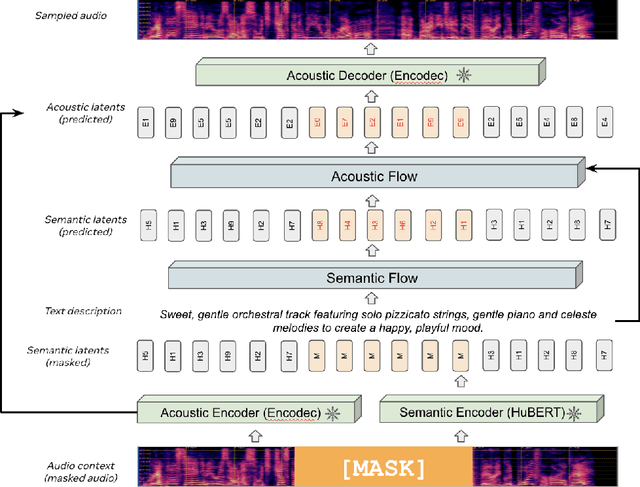

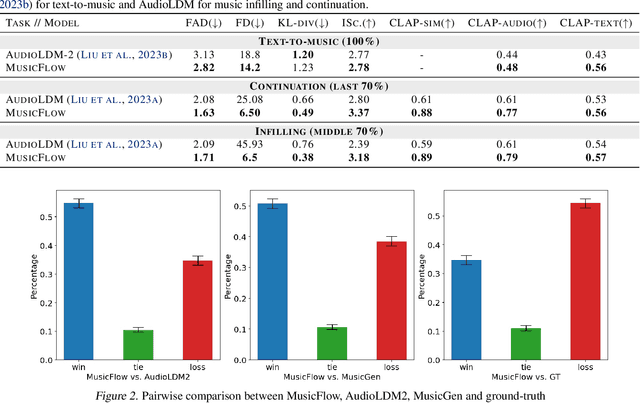
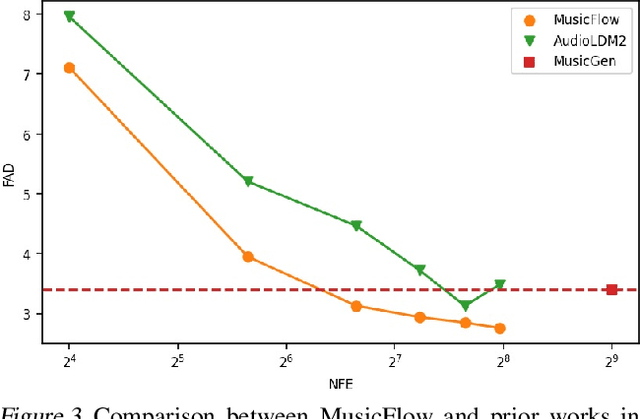
Abstract:We introduce MusicFlow, a cascaded text-to-music generation model based on flow matching. Based on self-supervised representations to bridge between text descriptions and music audios, we construct two flow matching networks to model the conditional distribution of semantic and acoustic features. Additionally, we leverage masked prediction as the training objective, enabling the model to generalize to other tasks such as music infilling and continuation in a zero-shot manner. Experiments on MusicCaps reveal that the music generated by MusicFlow exhibits superior quality and text coherence despite being over $2\sim5$ times smaller and requiring $5$ times fewer iterative steps. Simultaneously, the model can perform other music generation tasks and achieves competitive performance in music infilling and continuation. Our code and model will be publicly available.
Movie Gen: A Cast of Media Foundation Models
Oct 17, 2024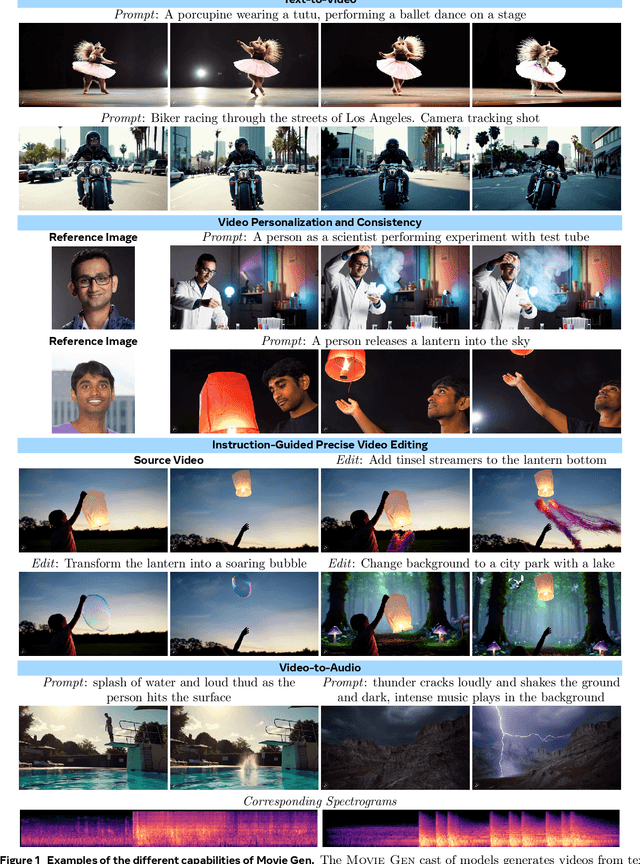

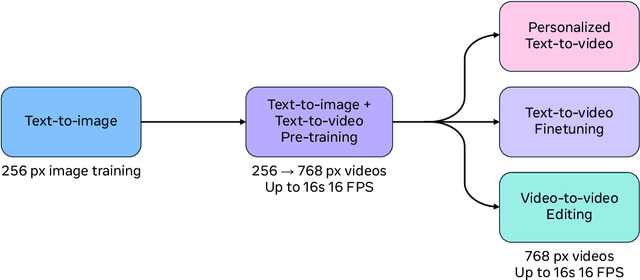
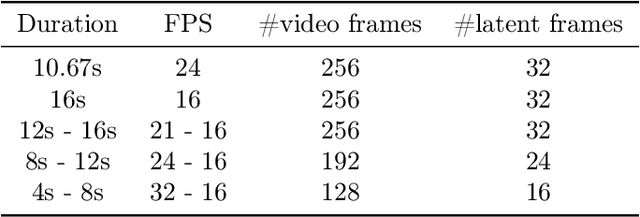
Abstract:We present Movie Gen, a cast of foundation models that generates high-quality, 1080p HD videos with different aspect ratios and synchronized audio. We also show additional capabilities such as precise instruction-based video editing and generation of personalized videos based on a user's image. Our models set a new state-of-the-art on multiple tasks: text-to-video synthesis, video personalization, video editing, video-to-audio generation, and text-to-audio generation. Our largest video generation model is a 30B parameter transformer trained with a maximum context length of 73K video tokens, corresponding to a generated video of 16 seconds at 16 frames-per-second. We show multiple technical innovations and simplifications on the architecture, latent spaces, training objectives and recipes, data curation, evaluation protocols, parallelization techniques, and inference optimizations that allow us to reap the benefits of scaling pre-training data, model size, and training compute for training large scale media generation models. We hope this paper helps the research community to accelerate progress and innovation in media generation models. All videos from this paper are available at https://go.fb.me/MovieGenResearchVideos.
High Fidelity Text-Guided Music Generation and Editing via Single-Stage Flow Matching
Jul 04, 2024



Abstract:We introduce a simple and efficient text-controllable high-fidelity music generation and editing model. It operates on sequences of continuous latent representations from a low frame rate 48 kHz stereo variational auto encoder codec that eliminates the information loss drawback of discrete representations. Based on a diffusion transformer architecture trained on a flow-matching objective the model can generate and edit diverse high quality stereo samples of variable duration, with simple text descriptions. We also explore a new regularized latent inversion method for zero-shot test-time text-guided editing and demonstrate its superior performance over naive denoising diffusion implicit model (DDIM) inversion for variety of music editing prompts. Evaluations are conducted on both objective and subjective metrics and demonstrate that the proposed model is not only competitive to the evaluated baselines on a standard text-to-music benchmark - quality and efficiency-wise - but also outperforms previous state of the art for music editing when combined with our proposed latent inversion. Samples are available at https://melodyflow.github.io.
Action2Sound: Ambient-Aware Generation of Action Sounds from Egocentric Videos
Jun 13, 2024


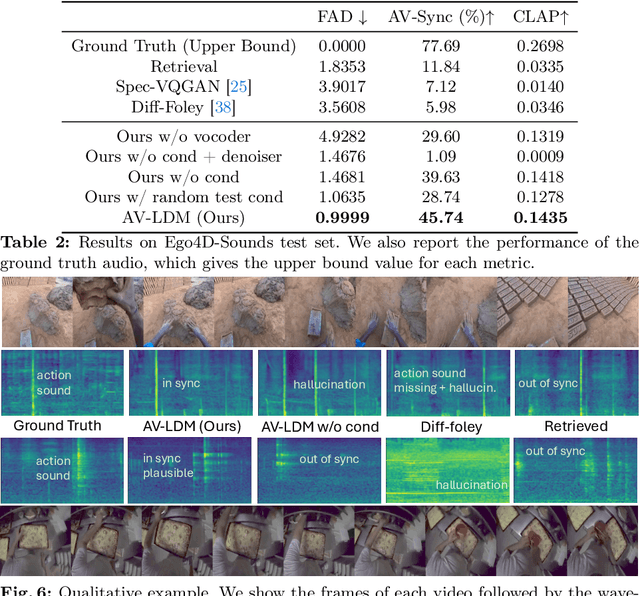
Abstract:Generating realistic audio for human interactions is important for many applications, such as creating sound effects for films or virtual reality games. Existing approaches implicitly assume total correspondence between the video and audio during training, yet many sounds happen off-screen and have weak to no correspondence with the visuals -- resulting in uncontrolled ambient sounds or hallucinations at test time. We propose a novel ambient-aware audio generation model, AV-LDM. We devise a novel audio-conditioning mechanism to learn to disentangle foreground action sounds from the ambient background sounds in in-the-wild training videos. Given a novel silent video, our model uses retrieval-augmented generation to create audio that matches the visual content both semantically and temporally. We train and evaluate our model on two in-the-wild egocentric video datasets Ego4D and EPIC-KITCHENS. Our model outperforms an array of existing methods, allows controllable generation of the ambient sound, and even shows promise for generalizing to computer graphics game clips. Overall, our work is the first to focus video-to-audio generation faithfully on the observed visual content despite training from uncurated clips with natural background sounds.
Learning Fine-Grained Controllability on Speech Generation via Efficient Fine-Tuning
Jun 10, 2024Abstract:As the scale of generative models continues to grow, efficient reuse and adaptation of pre-trained models have become crucial considerations. In this work, we propose Voicebox Adapter, a novel approach that integrates fine-grained conditions into a pre-trained Voicebox speech generation model using a cross-attention module. To ensure a smooth integration of newly added modules with pre-trained ones, we explore various efficient fine-tuning approaches. Our experiment shows that the LoRA with bias-tuning configuration yields the best performance, enhancing controllability without compromising speech quality. Across three fine-grained conditional generation tasks, we demonstrate the effectiveness and resource efficiency of Voicebox Adapter. Follow-up experiments further highlight the robustness of Voicebox Adapter across diverse data setups.
Tango 2: Aligning Diffusion-based Text-to-Audio Generations through Direct Preference Optimization
Apr 16, 2024



Abstract:Generative multimodal content is increasingly prevalent in much of the content creation arena, as it has the potential to allow artists and media personnel to create pre-production mockups by quickly bringing their ideas to life. The generation of audio from text prompts is an important aspect of such processes in the music and film industry. Many of the recent diffusion-based text-to-audio models focus on training increasingly sophisticated diffusion models on a large set of datasets of prompt-audio pairs. These models do not explicitly focus on the presence of concepts or events and their temporal ordering in the output audio with respect to the input prompt. Our hypothesis is focusing on how these aspects of audio generation could improve audio generation performance in the presence of limited data. As such, in this work, using an existing text-to-audio model Tango, we synthetically create a preference dataset where each prompt has a winner audio output and some loser audio outputs for the diffusion model to learn from. The loser outputs, in theory, have some concepts from the prompt missing or in an incorrect order. We fine-tune the publicly available Tango text-to-audio model using diffusion-DPO (direct preference optimization) loss on our preference dataset and show that it leads to improved audio output over Tango and AudioLDM2, in terms of both automatic- and manual-evaluation metrics.
XLAVS-R: Cross-Lingual Audio-Visual Speech Representation Learning for Noise-Robust Speech Perception
Mar 21, 2024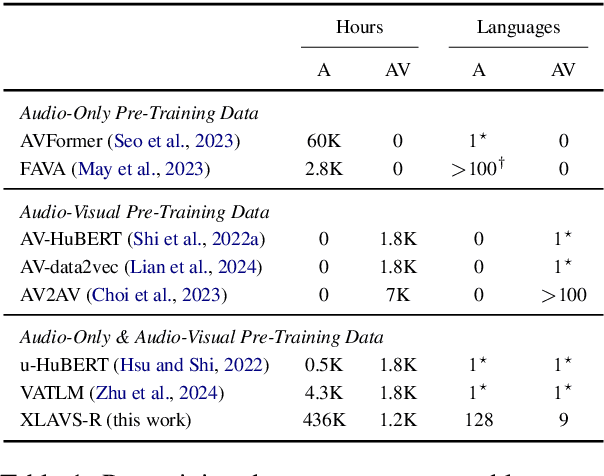
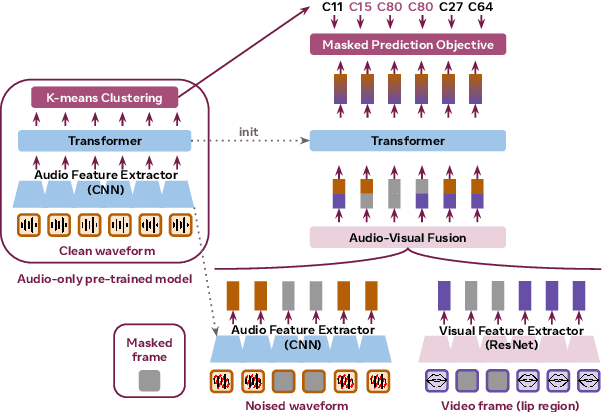
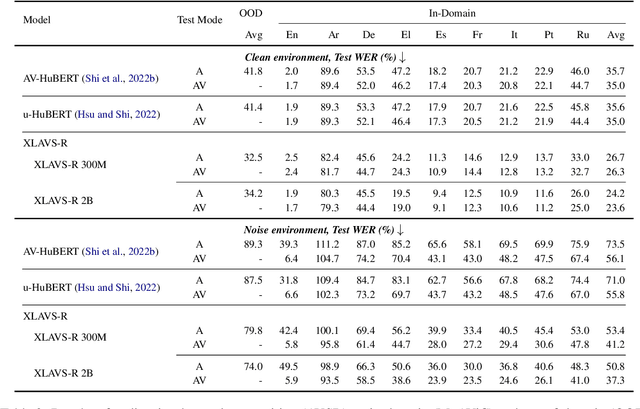
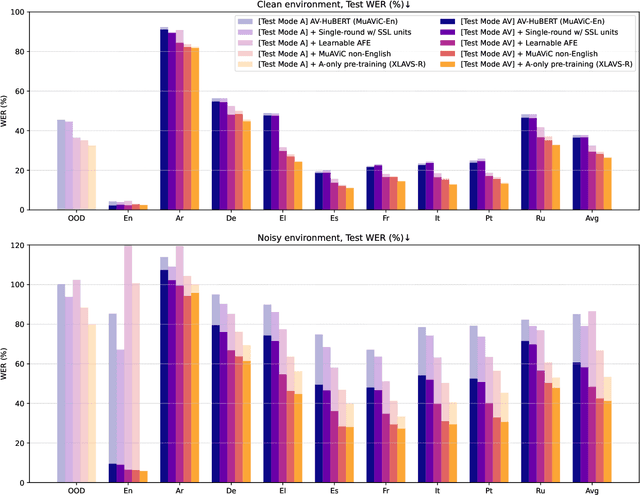
Abstract:Speech recognition and translation systems perform poorly on noisy inputs, which are frequent in realistic environments. Augmenting these systems with visual signals has the potential to improve robustness to noise. However, audio-visual (AV) data is only available in limited amounts and for fewer languages than audio-only resources. To address this gap, we present XLAVS-R, a cross-lingual audio-visual speech representation model for noise-robust speech recognition and translation in over 100 languages. It is designed to maximize the benefits of limited multilingual AV pre-training data, by building on top of audio-only multilingual pre-training and simplifying existing pre-training schemes. Extensive evaluation on the MuAViC benchmark shows the strength of XLAVS-R on downstream audio-visual speech recognition and translation tasks, where it outperforms the previous state of the art by up to 18.5% WER and 4.7 BLEU given noisy AV inputs, and enables strong zero-shot audio-visual ability with audio-only fine-tuning.
 Add to Chrome
Add to Chrome Add to Firefox
Add to Firefox Add to Edge
Add to Edge